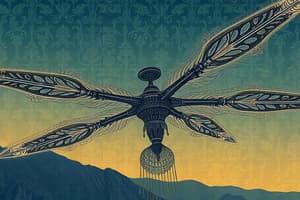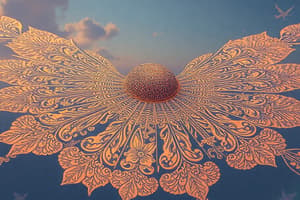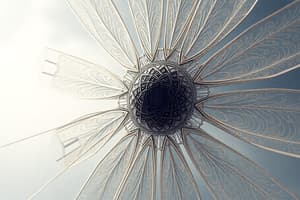Podcast
Questions and Answers
Which rotor blade design is known for having superior aerodynamic pitch characteristics?
Which rotor blade design is known for having superior aerodynamic pitch characteristics?
- Symmetrical (correct)
- Tapered
- Parallel
- Asymmetrical
Which rotor blade design achieves greater lift for the same surface area?
Which rotor blade design achieves greater lift for the same surface area?
- Asymmetrical (correct)
- Uniform
- Symmetrical
- Parallel
What is the primary method engineers use to achieve similar pitching characteristics from an asymmetrical blade?
What is the primary method engineers use to achieve similar pitching characteristics from an asymmetrical blade?
- Adding more trim weights
- Increasing the camber
- Decreasing the angle of attack
- Sweeping the edges 3 degrees upwards (correct)
Why are symmetrical rotor blade designs more commonly used?
Why are symmetrical rotor blade designs more commonly used?
Which rotor blade planform features a leading and trailing edge running parallel to each other?
Which rotor blade planform features a leading and trailing edge running parallel to each other?
Why do uniform blade planforms create greater lift?
Why do uniform blade planforms create greater lift?
What is the primary reason manufacturers prefer to produce uniform blade planforms?
What is the primary reason manufacturers prefer to produce uniform blade planforms?
Why are parallel blades designed with a negative twist?
Why are parallel blades designed with a negative twist?
What is the primary reason for painting the bottom of rotor blades flat black?
What is the primary reason for painting the bottom of rotor blades flat black?
Which material is NOT commonly associated with helicopter rotor blades?
Which material is NOT commonly associated with helicopter rotor blades?
What is the purpose of the stainless steel capping on the leading edges of rotor blades?
What is the purpose of the stainless steel capping on the leading edges of rotor blades?
What is used to check a composite rotor blade for damage?
What is used to check a composite rotor blade for damage?
What is the effect of adding weight to the leading edge of a rotor blade?
What is the effect of adding weight to the leading edge of a rotor blade?
If you wanted to make a rotor blade fly higher in its plane of rotation, how would you adjust the trim tab?
If you wanted to make a rotor blade fly higher in its plane of rotation, how would you adjust the trim tab?
During pre-rigging preparations, what is the first action to be completed?
During pre-rigging preparations, what is the first action to be completed?
Which part of the helicopter gets rigged first?
Which part of the helicopter gets rigged first?
What is the correct order for rigging the flight controls?
What is the correct order for rigging the flight controls?
What is the primary function of the main servo flap?
What is the primary function of the main servo flap?
What is the purpose of the correlator in a helicopter?
What is the purpose of the correlator in a helicopter?
How many gradient actuators are there if all flight control systems have force trim?
How many gradient actuators are there if all flight control systems have force trim?
What type of airfoil will a fixed elevator on a helicopter have?
What type of airfoil will a fixed elevator on a helicopter have?
Which of these describes a benefit of a servo flap?
Which of these describes a benefit of a servo flap?
Which of these devices has a weighted drum supported by three springs?
Which of these devices has a weighted drum supported by three springs?
What is the purpose of the droop compensator in a helicopter's control system?
What is the purpose of the droop compensator in a helicopter's control system?
Flashcards
Symmetrical Rotor Blade Design
Symmetrical Rotor Blade Design
This design features a symmetrical airfoil shape, resulting in consistent aerodynamic characteristics throughout the blade.
Asymmetrical Rotor Blade Design
Asymmetrical Rotor Blade Design
This design uses an airfoil with a higher camber on one side than the other, creating greater lift for the same surface area.
Parallel (Uniform) Blade Planform
Parallel (Uniform) Blade Planform
This planform has the leading and trailing edges running parallel to each other, creating a uniform chord length.
Tapered Blade Planform
Tapered Blade Planform
Signup and view all the flashcards
Bonded Construction
Bonded Construction
Signup and view all the flashcards
Single Pocket Skin Configuration
Single Pocket Skin Configuration
Signup and view all the flashcards
Multi Pocket Skin Configuration
Multi Pocket Skin Configuration
Signup and view all the flashcards
Trim Balance Weight
Trim Balance Weight
Signup and view all the flashcards
Why are the leading edges of rotor blades capped with stainless steel?
Why are the leading edges of rotor blades capped with stainless steel?
Signup and view all the flashcards
Why are rotor blades painted flat black on the bottom?
Why are rotor blades painted flat black on the bottom?
Signup and view all the flashcards
What type of rotor blades require static discharge abilities?
What type of rotor blades require static discharge abilities?
Signup and view all the flashcards
What is the primary inspection method for composite rotor blades?
What is the primary inspection method for composite rotor blades?
Signup and view all the flashcards
What is the purpose of double plates at the root of the blade tip?
What is the purpose of double plates at the root of the blade tip?
Signup and view all the flashcards
Where are spanwise balance weights located on the rotor blade?
Where are spanwise balance weights located on the rotor blade?
Signup and view all the flashcards
Where are chordwise mass balance weights located on the rotor blade?
Where are chordwise mass balance weights located on the rotor blade?
Signup and view all the flashcards
What are trim tabs?
What are trim tabs?
Signup and view all the flashcards
What is a servo flap?
What is a servo flap?
Signup and view all the flashcards
What are the main benefits of a servo flap?
What are the main benefits of a servo flap?
Signup and view all the flashcards
What is the correlator?
What is the correlator?
Signup and view all the flashcards
What is the droop compensator?
What is the droop compensator?
Signup and view all the flashcards
What is a Bifilar vibration absorber?
What is a Bifilar vibration absorber?
Signup and view all the flashcards
What is a Hub vibration absorber?
What is a Hub vibration absorber?
Signup and view all the flashcards
What is the gradient spring in a force trim system?
What is the gradient spring in a force trim system?
Signup and view all the flashcards
What kind of airfoil is found on fixed elevators?
What kind of airfoil is found on fixed elevators?
Signup and view all the flashcards
Study Notes
Rotor Blade Designs
- Two main designs: symmetrical and asymmetrical
- Symmetrical blades have better aerodynamic pitch characteristics
- Asymmetrical blades generate more lift for the same surface area
- Asymmetrical blades have greater camber on one side
- Engineers achieve similar characteristics in asymmetrical blades by sweeping edges upwards
- Symmetrical blades are the most common design due to asymmetrical blade instability.
Planform Types
- Two types: Parallel (uniform) and tapered
- Uniform planform: leading and trailing edges are parallel
- Uniform creates greater lift because of chord line
- Tapered planform: converging leading and trailing edges, decreasing chord length towards the blade root
Manufacturing Preferences
- Manufacturers prefer uniform planforms due to cost-effectiveness.
- Uniform planforms use a single machine stamping for ribs, eliminating rib part number changes.
- Tapered planforms require different ribs for each rib due to uneven chord length.
- Tapered planforms provide more equal lift due to varying speed.
Blade Twist
- Parallel blades have negative twist to achieve the same lift from root and tip, despite the slower tip speed.
Skin Configurations
- Single pocket skin is quicker to build, since it uses one large skin piece
- Multi-pocket skin is easier to repair because damaged sections can be replaced.
- Single-pocket damage results in discarding the entire blade.
Bonded Construction
- Bonded construction is stronger than traditional methods, and avoids drilling holes.
Rotor Blade Painting
- Bottom of rotor blades are painted black to prevent glare.
Static Discharge
- Composite blades require static discharge abilities
Studying That Suits You
Use AI to generate personalized quizzes and flashcards to suit your learning preferences.




